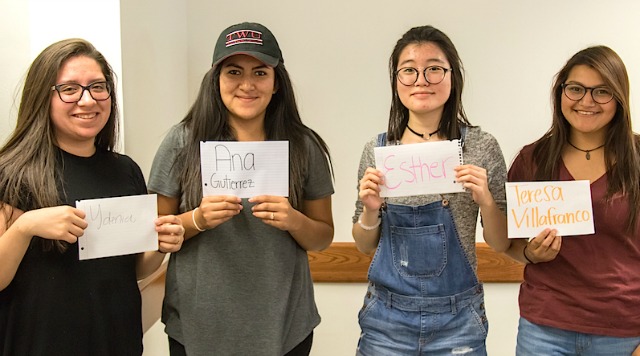Regardless of whether you’ve been teaching for 15 years or 15 minutes, how to act and what to do on the first day of class seems to be something many faculty are constantly revising. The impact of the lasting nature of the first impression may lead to nervousness on the first day of the semester. Consequently, many of us may feel pressured to adopt a personality or plan that doesn’t necessarily resonate with who we are for the rest of the semester or in our outside lives.
We’ve discovered some ways that not only help you feel prepared for class but also create an authentic community conducive to learning in a non-threatening environment. What follows are a few of our best practices.
Be personable and authentic
New faculty are often advised to project a no-nonsense air of confidence, but how long can you really keep up playing a role? It’s far more productive to find ways to “personalize” the first day of class instead of hiding behind bureaucratic procedures, such as reading through the syllabus or driving home all your rules and expectations. Letting students see us as human beings can lay the foundation for a successful and engaging semester. Hopefully, they will let us see the human side of them as well. Telling students a good personal story about your life is a way to
capture their attention and start building a connection on that first day.
An excellent approach for developing an authentic relationship with your students, as well as combat initial nervousness, is to ask students to answer questions about themselves on a notecard at the beginning of class. This will not only give you a few quiet minutes to gather your thoughts, but it will also help you to get to know your new students. In addition to the common practice of collecting contact info, it can be insightful to also ask what prompted students to take the class, how they found out about it, where they are from originally, their preferred gender pronoun, hobbies and interests, and whether they speak any other languages. This will provide you with fodder for future discussions and for relating course content to students’ lives.
Another effective way to build community in the class without sacrificing a lot of time is to combine an attendance sheet with a mini-questionnaire. On the left-hand side is the column where students sign in with their name, but on the right-hand side we always put a “Question of the day/week.” Here students answer a question or finish a prompt. This is a small addition that can help to develop and deepen the sense of class community and get students ready to learn. If you are savvy and have a good memory you can integrate or intersperse what you learn from these mini-questionnaires into future class discussions (
“Ashley, you mentioned you are interested in film noir/climate change/macramé…”). Some of the prompts can be about the assignments or readings done for the class (
One thing I remember/did not understand), others could be on there just for fun:
my favorite movie/song/TV show. You could also start them off with a saying or a sentence fragment they have to finish:
This summer I will…., The best things in life are…., After college I plan on…., My dream place to visit is…. Before class begins and during breaks, we often overhear groups chatting about the answers they read on the sign-in sheet.
Learning students’ names
Another way to strengthen the class community is to address students by name and encourage students to get to know as many of their classmates as they can. In large classes, it is especially difficult for the instructor to learn everyone’s name, and students often can make it through the whole semester without knowing more than the two or three people sitting directly next to them. A good way to memorize students’ names (and to help introduce them to each other) is to ask everyone to take a sheet of paper and create a table tent with their name written in BIG letters, so it is easily legible. Students need to hold on to their tents and bring them to class for the first few weeks until you and others have learned their names. What we found most effective is to take digital photos of students holding up their name tags in groups of three or four. This can be a fun icebreaker activity, having students pose for “mugshots” in small groups speeds up the process, and these photos can then be posted in the LMS course shell for easy reference.

Whether you teach music, business, or nursing, these strategies are easily transferable to other disciplines and different instructional environments. We find it important and immensely rewarding to invest the energy into attracting students to the classroom and inviting them to stay and participate in an ongoing dialogue. Mere facts can be learned from a textbook or any number of media available on the Internet. Our goal is to create a lively, challenging, and welcoming environment that engages students in their learning.
Jörg Waltje is the executive director of the Center for Faculty Excellence at Texas Woman’s University. His interests include effective faculty development and tinkering with new technologies for the continuous improvement of the teaching/learning experience in higher education. Aubree Evans is the coordinator of teaching, learning, and academic excellence in the Center for Faculty Excellence at Texas Woman’s University. Her background is in instructional design and writing instruction.
(All students signed photo releases and have agreed to their images being used in presentations and publications.)







 Whether you teach music, business, or nursing, these strategies are easily transferable to other disciplines and different instructional environments. We find it important and immensely rewarding to invest the energy into attracting students to the classroom and inviting them to stay and participate in an ongoing dialogue. Mere facts can be learned from a textbook or any number of media available on the Internet. Our goal is to create a lively, challenging, and welcoming environment that engages students in their learning.
Jörg Waltje is the executive director of the Center for Faculty Excellence at Texas Woman’s University. His interests include effective faculty development and tinkering with new technologies for the continuous improvement of the teaching/learning experience in higher education. Aubree Evans is the coordinator of teaching, learning, and academic excellence in the Center for Faculty Excellence at Texas Woman’s University. Her background is in instructional design and writing instruction.
Whether you teach music, business, or nursing, these strategies are easily transferable to other disciplines and different instructional environments. We find it important and immensely rewarding to invest the energy into attracting students to the classroom and inviting them to stay and participate in an ongoing dialogue. Mere facts can be learned from a textbook or any number of media available on the Internet. Our goal is to create a lively, challenging, and welcoming environment that engages students in their learning.
Jörg Waltje is the executive director of the Center for Faculty Excellence at Texas Woman’s University. His interests include effective faculty development and tinkering with new technologies for the continuous improvement of the teaching/learning experience in higher education. Aubree Evans is the coordinator of teaching, learning, and academic excellence in the Center for Faculty Excellence at Texas Woman’s University. Her background is in instructional design and writing instruction.